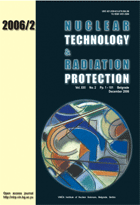
RADIATION SHIELDING ASPECTS FOR LONG MANNED MISSION TO SPACE
- Criteria, Survey Study, and Preliminary Model -

December 2006
UDC 621.039+614.876:504.06
YU ISSN 1451-3994
....Back to Contents
Pages: 47 - 66
Authors: Manuel SZTEJNBERG, Shanjie XIAO, Nader SATVAT, Felisa LIMÓN, John HOPKINS, Tatjana JEVREMOVIC
AbstractThe prospect of manned space missions out side Earth's orbit is limited by the travel time and shielding against cosmic radiation. The chemical rockets currently used in the space program have no hope of propelling a manned vehicle to a far away location such as Mars due to the enormous mass of fuel that would be required. The specific energy available from nuclear fuel is a factor of 106 higher than chemical fuel; it is therefore obvious that nuclear power production in space is a must. On the other hand, recent considerations to send a man to the Moon for a long stay would require a stable, secured, and safe source of energy (there is hardly anything beyond nuclear power that would provide a useful and reliably safe sustainable supply of energy). National Aeronautics and Space Administration (NASA) anticipates that the mass of a shielding material required for long travel to Mars is the next major design driver. In 2006 NASA identified a need to assess and evaluate potential gaps in existing knowledge and understanding of the level and types of radiation critical to astronauts' health during the long travel to Mars and to start a comprehensive study related to the shielding design of a spacecraft finding the conditions for the mitigation of radiation components contributing to the doses beyond accepted limits. In order to reduce the overall space craft mass, NASA is looking for the novel, multi-purpose and multi-functional materials that will provide effective shielding of the crew and electronics on board. The Laboratory for Neutronics and Geometry Computation in the School of Nuclear Engineering at Purdue University led by Prof. Tatjana Jevremovic began in 2004 the analytical evaluations of different lightweight materials. The preliminary results of the design survey study are presented in this paper.
Key words: long mission to space, cosmic radiation, shielding, Monte Carlo method, radiation transport
FULL PAPER IN PDF FORMAT (2.07 MB)
Last updated on September, 2010